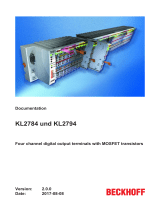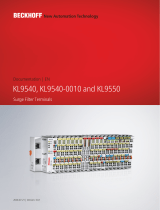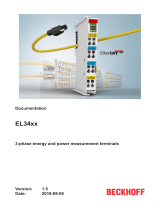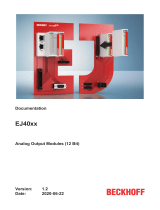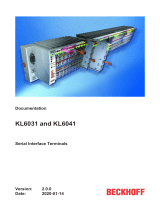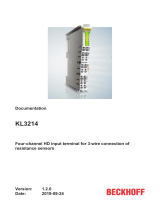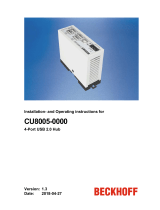Page is loading ...

Documentation
KL2602, KL2622, KL2634
Two-and four-channel Relay Output Terminals
2.4.0
2019-09-23
Version:
Date:


Table of contents
KL2602, KL2622, KL2634 3Version: 2.4.0
Table of contents
1 Foreword ....................................................................................................................................................5
1.1 Notes on the documentation..............................................................................................................5
1.2 Safety instructions .............................................................................................................................6
1.3 Documentation Issue Status..............................................................................................................7
1.4 Beckhoff Identification Code (BIC) ....................................................................................................7
2 Product overview.....................................................................................................................................10
2.1 KL2602-00x0, KL2622-00x0 - Introduction......................................................................................11
2.2 KL2602-00x0, KL2622-00x0 - Technical data .................................................................................13
2.3 KL2634-0000 - Introduction .............................................................................................................15
2.4 KL2634-0000 - Technical data ........................................................................................................16
3 Mounting and wiring................................................................................................................................17
3.1 Instructions for ESD protection........................................................................................................17
3.2 Installation on mounting rails ...........................................................................................................17
3.3 Connection ......................................................................................................................................20
3.3.1 Connection system .......................................................................................................... 20
3.3.2 Wiring............................................................................................................................... 22
3.4 KL2602-00x0 - Connector pin assignment and LEDs .....................................................................24
3.5 KL2622-00x0 - Connector pin assignment and LEDs .....................................................................25
3.6 KL2634-0000 - Connector pin assignment and LEDs .....................................................................26
3.7 ATEX - Special conditions (extended temperature range) ..............................................................27
3.8 ATEX Documentation ......................................................................................................................28
4 Commissioning........................................................................................................................................29
4.1 Remarks for usage of relay terminals..............................................................................................29
4.2 Notes on contact-protecting switching of the EL26x2-0010/ KL26x2-0010 terminals .....................30
5 Appendix ..................................................................................................................................................32
5.1 Support and Service ........................................................................................................................32

Table of contents
KL2602, KL2622, KL26344 Version: 2.4.0

Foreword
KL2602, KL2622, KL2634 5Version: 2.4.0
1 Foreword
1.1 Notes on the documentation
Intended audience
This description is only intended for the use of trained specialists in control and automation engineering who
are familiar with the applicable national standards.
It is essential that the documentation and the following notes and explanations are followed when installing
and commissioning these components.
It is the duty of the technical personnel to use the documentation published at the respective time of each
installation and commissioning.
The responsible staff must ensure that the application or use of the products described satisfy all the
requirements for safety, including all the relevant laws, regulations, guidelines and standards.
Disclaimer
The documentation has been prepared with care. The products described are, however, constantly under
development.
We reserve the right to revise and change the documentation at any time and without prior announcement.
No claims for the modification of products that have already been supplied may be made on the basis of the
data, diagrams and descriptions in this documentation.
Trademarks
Beckhoff
®
, TwinCAT
®
, EtherCAT
®
, EtherCATG
®
, EtherCATG10
®
, EtherCATP
®
, SafetyoverEtherCAT
®
,
TwinSAFE
®
, XFC
®
, XTS
®
and XPlanar
®
are registered trademarks of and licensed by Beckhoff Automation
GmbH. Other designations used in this publication may be trademarks whose use by third parties for their
own purposes could violate the rights of the owners.
Patent Pending
The EtherCAT Technology is covered, including but not limited to the following patent applications and
patents: EP1590927, EP1789857, EP1456722, EP2137893, DE102015105702 with corresponding
applications or registrations in various other countries.
EtherCAT
®
is registered trademark and patented technology, licensed by Beckhoff Automation GmbH,
Germany.
Copyright
© Beckhoff Automation GmbH & Co. KG, Germany.
The reproduction, distribution and utilization of this document as well as the communication of its contents to
others without express authorization are prohibited.
Offenders will be held liable for the payment of damages. All rights reserved in the event of the grant of a
patent, utility model or design.

Foreword
KL2602, KL2622, KL26346 Version: 2.4.0
1.2 Safety instructions
Safety regulations
Please note the following safety instructions and explanations!
Product-specific safety instructions can be found on following pages or in the areas mounting, wiring,
commissioning etc.
Exclusion of liability
All the components are supplied in particular hardware and software configurations appropriate for the
application. Modifications to hardware or software configurations other than those described in the
documentation are not permitted, and nullify the liability of Beckhoff Automation GmbH & Co. KG.
Personnel qualification
This description is only intended for trained specialists in control, automation and drive engineering who are
familiar with the applicable national standards.
Description of instructions
In this documentation the following instructions are used.
These instructions must be read carefully and followed without fail!
DANGER
Serious risk of injury!
Failure to follow this safety instruction directly endangers the life and health of persons.
WARNING
Risk of injury!
Failure to follow this safety instruction endangers the life and health of persons.
CAUTION
Personal injuries!
Failure to follow this safety instruction can lead to injuries to persons.
NOTE
Damage to environment/equipment or data loss
Failure to follow this instruction can lead to environmental damage, equipment damage or data loss.
Tip or pointer
This symbol indicates information that contributes to better understanding.

Foreword
KL2602, KL2622, KL2634 7Version: 2.4.0
1.3 Documentation Issue Status
Version Comment
2.4.0 • Update chapter “Instructions for ESD protection”
• Chapter “Beckhoff Identification Code (BIC)” added
2.3.0 • Technical data updated
2.2.0 • KL2634 added
• Chapter “Instructions for ESD protection” added
• Update chapter “Remarks for usage of relay terminals
• Update structure
2.1.1 • Chapter “Notes on contact-protecting switching of the EL26x2-0010/ KL26x2-0010 terminals”
updated
• Technical data updated
2.1.0 • Chapter “Connection” updated
• Technical data updated
2.0.0 • Migration
• KL2602-0010 and KL2622-0010 added
1.4 • Technical data updated
• Notes about ATEX added
1.3 • Foreword updated
• Pictures adapted to LED prism
1.2 • Technical data updated
• Foreword and appendix added
• English translation available
1.1 • Company name changed to Beckhoff Automation GmbH
• Layout updated
1.0 • First release
Firmware and hardware versions
The firmware and hardware versions (delivery state) can be taken from the serial number printed on the side
of the terminal.
Syntax of the serial number
Structure of the serial number: WW YY FF HH
WW - week of production (calendar week)
YY - year of production
FF - firmware version
HH - hardware version
Example with ser. no.: 40 15 1A 00:
40 - week of production 40
15 - year of production 2015
1A - firmware version 1A
00 - hardware version 00
1.4 Beckhoff Identification Code (BIC)
The Beckhoff Identification Code (BIC) is increasingly being applied to Beckhoff products to uniquely identify
the product. The BIC is represented as a Data Matrix Code (DMC, code scheme ECC200), the content is
based on the ANSI standard MH10.8.2-2016.

Foreword
KL2602, KL2622, KL26348 Version: 2.4.0
Fig.1: BIC as data matrix code (DMC, code scheme ECC200)
The BIC will be introduced step by step across all product groups.
Depending on the product, it can be found in the following places:
• on the packaging unit
• directly on the product (if space suffices)
• on the packaging unit and the product
The BIC is machine-readable and contains information that can also be used by the customer for handling
and product management.
Each piece of information can be uniquely identified using the so-called data identifier
(ANSIMH10.8.2-2016). The data identifier is followed by a character string. Both together have a maximum
length according to the table below. If the information is shorter, spaces are added to it. The data under
positions 1 to 4 are always available.
The following information is contained:
Item
no.
Type of
information
Explanation Data
identifier
Number of digits
incl. data identifier
Example
1 Beckhoff order
number
Beckhoff order number 1P 8 1P072222
2 Beckhoff Traceability
Number (BTN)
Unique serial number,
see note below
S 12 SBTNk4p562d7
3 Article description Beckhoff article
description, e.g.
EL1008
1K 32 1KEL1809
4 Quantity Quantity in packaging
unit, e.g. 1, 10, etc.
Q 6 Q1
5 Batch number Optional: Year and week
of production
2P 14 2P401503180016
6 ID/serial number Optional: Present-day
serial number system,
e.g. with safety products
51S 12 51S678294104
7 Variant number Optional: Product variant
number on the basis of
standard products
30P 32 30PF971, 2*K183
...

Foreword
KL2602, KL2622, KL2634 9Version: 2.4.0
Further types of information and data identifiers are used by Beckhoff and serve internal processes.
Structure of the BIC
Example of composite information from item 1 to 4 and 6. The data identifiers are marked in red for better
display:
BTN
An important component of the BIC is the Beckhoff Traceability Number (BTN, item no.2). The BTN is a
unique serial number consisting of eight characters that will replace all other serial number systems at
Beckhoff in the long term (e.g. batch designations on IO components, previous serial number range for
safety products, etc.). The BTN will also be introduced step by step, so it may happen that the BTN is not yet
coded in the BIC.
NOTE
This information has been carefully prepared. However, the procedure described is constantly being further
developed. We reserve the right to revise and change procedures and documentation at any time and with-
out prior notice. No claims for changes can be made from the information, illustrations and descriptions in
this information.

Product overview
KL2602, KL2622, KL263410 Version: 2.4.0
2 Product overview
KL2602-0000 [}11]
Dual channel relay output terminal, 250V
AC
, make contacts
KL2602-0010 [}11]
Dual channel relay output terminal, 230V
AC
, make contacts, soft switching
KL2622-0000 [}11]
Dual channel relay output terminal, 250V
AC
, potential-free make contacts
KL2622-0010 [}11]
Dual channel relay output terminal, 230V
AC
, make contacts, without power,
contacts soft switching,
KL2634-0000 [}15]
Four channel relay output terminal, 250V
AC
, potential-free make contacts,

Product overview
KL2602, KL2622, KL2634 11Version: 2.4.0
2.1 KL2602-00x0, KL2622-00x0 - Introduction
Fig.2: KL2602, KL2602-0010
Fig.3: KL2622, KL2622-0010
The KL2602/ KL2602-0010 (2x normally open, with power contacts) and KL2622/ KL2622-0010 (2x
normally open) output terminals have two relays each of which has a single contact. The relay contact of the
KL2602/ KL2602-0010 is connected to the power contacts and can be generally used for switching devices
requiring mains power. The Bus Terminals indicate their signal state by means of light emitting diodes. The
KL2622-0000 and KL2622-0010 bus terminals have potential-free contacts. The power contacts L and N are
not looped through.
The relay terminals KL2602-0010 and KL2622-0010 are designed for soft switching in the range of zero
voltage crossing to protect the contacts and is particularly suitable for capacitive loads such as LED lamps
(or their chokes).

Product overview
KL2602, KL2622, KL263412 Version: 2.4.0
Watchdogtimer-Overflow
If no process data is transferred to the terminal from the Bus Coupler for 100ms, the green signal-LEDs go
out, and the relay contacts are opened after typical reaction time (see Technical data [}13]).
Process data
The bit-width in the process image is 2bits.

Product overview
KL2602, KL2622, KL2634 13Version: 2.4.0
2.2 KL2602-00x0, KL2622-00x0 - Technical data
KL2602-0000 and KL2622-0000
Technical data KL2602-0000 KL2622-0000
Number of outputs 2 N/O contacts for power
contact
2 N/O contacts (potential free)
Contact material AgCdO
Switching voltage max. 250V
AC
/ 30V
DC
Switching current Max. 5A
Switching capacity max. with resistive load Alternating voltage:
5A250V
AC
1250VA
Direct voltage:
5A30V
DC
150W
Maximum switching current
with inductive load, cosφ=0.4, L/R=7ms
2A250V
AC
2A30V
DC
Minimum permitted load (approximate) 10mA at 5V
DC
(as supplied)
100mA at 5V
DC
(after a current of approx. 100mA
(or greater) has been switched at least once)
Reaction time at a rated load Reaction time: max. 10ms
Release time: max. 4ms
Bounce time: max. 5ms
Electrical isolation 500V (K-Bus / mains voltage)
K-Bus current consumption 80mA 85mA
Bit width in process image 2outputs
Service life Mechanical operating cycles 20,000,000 switching operations
Service life Electrical operating cycles At least 100,000 switching operations on resistive loads at
250V
AC
5A or
30V
DC
5A
Permitted switching frequency at
maximum contact load
10 switching operations / minute
Contact resistance max. (new) < 30mΩ
Insulation resistance (min). 100MΩ at 500V
DC
Test voltage between open contacts 750V (1 minute between open contacts)
Configuration no address or configuration settings
Weight approx. 85g approx. 80g
Dimensions (W x H x D) approx. 15mm x 100mm x 70mm (width aligned: 12mm)
Mounting [}17]
on 35mm mounting rail according to EN 60715
Permissible ambient temperature range
during operation
-25°C…+60°C
Permissible ambient temperature range
during storage
-40°C ... +85°C
Permissible relative humidity 95 %, no condensation
Vibration/shock resistance conforms to EN 60068-2-6/EN 60068-2-27
EMC immunity/emission conforms to EN 61000-6-2/EN 61000-6-4
Installation position Variable
Protect. class IP20
Approvals
CE, cULus, ATEX [}28], GL

Product overview
KL2602, KL2622, KL263414 Version: 2.4.0
KL2602-0010 and KL2622-0010
Technical data KL2602-0010 KL2622-0010
Number of outputs 2 x make contacts for power
contact
2 x make contacts
Contact material Ag-Alloy (Au plating applied to stationary contact)
Rated load voltage 230V
AC
/ 30V
DC
Load type ohmic, inductive, capacitive
Switching current max. typ. 5A
AC/DC
each channel
Switching current inductive typ. 2A
AC/DC
each channel
Minimal permissible load typ. 0.1mA at 0.1V
DC
Electrical isolation 500V (K-bus/field potential)
K-Bus current consumption 80mA 85mA
Bit width in the process image 2 outputs
Reaction time at a rated load max. 20ms (= 10ms zero crossing voltage delay at
50Hz+10ms delay time of the relay)
Operating cycles mech. (min.) 2 x 10
7
(at 18 x 10
3
switching cycles per hour)
Operating cycles electr. (min.) 100,000 (3A at 250V
AC
, 3A at 30V
DC
and ohmic load)
80,000 (5A at 250V
AC
, 5A at 30V
DC
and ohmic load)
100,000 (2A at 250V
AC
, 2A at 30V
DC
and inductive load)
Configuration no address or configuration settings
Special features Soft switching at the zero voltage crossing
Contact resistance (max.) typ. 100mΩ
Insulation resistance (min.) typ. 1000MΩ at 500V
DC
Weight approx. 50g
Dimensions (W x H x D) approx. 15mm x 100mm x 70mm (width aligned: 12mm)
Permissible ambient temperature range
during operation
0…+55 °C
Permissible ambient temperature range
during storage
-25…+85 °C
Permissible relative humidity 95 %, no condensation
Mounting [}17]
on 35mm mounting rail according to EN 60715
Vibration/shock resistance conforms to EN 60068-2-6/EN 60068-2-27
EMC immunity/emission conforms to EN 61000-6-2/EN 61000-6-4
Installation position Variable
Protect. class IP20
Approvals CE, cULus

Product overview
KL2602, KL2622, KL2634 15Version: 2.4.0
2.3 KL2634-0000 - Introduction
Fig.4: KL2634
The terminal and KL2634 (4x normally open) output terminal has four relays each of which has a single
contact. The Bus Terminals indicate their signal state by means of light emitting diodes. The KL2634 bus
terminal has potential-free contacts. The power contacts L and N are not looped through.
Watchdogtimer-Overflow
If no process data is transferred to the terminal from the Bus Coupler for 100ms, the green signal-LEDs go
out, and the relay contacts are opened after typical reaction time (see Technical data [}16]).
Process data
The bit-width in the process image is 4 bits.

Product overview
KL2602, KL2622, KL263416 Version: 2.4.0
2.4 KL2634-0000 - Technical data
Technical data KL2634-0000
Number of outputs 4 N/O contacts (potential-free)
Contact material Ag-Alloy (Au plating applied to stationary contact)
Switching voltage max. 250V
AC
/ 30V
DC
Load type Ohmic, inductive
Ohmic switching current Typ. 4A AC/DC per channel
Inductive switching current Typ. 2A AC/DC per channel
Minimum permitted load 0.1mA at 0.1V
DC
(at 120operations/min.)
Electrical isolation 500V (K-Bus / field potential)
K-Bus current consumption Typ. 120mA
Bit width in process image 4outputs
Reaction time at a rated load max. 20ms (= 10ms zero crossing voltage delay at
50Hz+10ms delay time of the relay)
Service life Mechanical operating cycles
(min.)
2 x 10
7
(18 x 10
3
switching cycles per hour)
Service life Electrical operating cycles
(min.)
2 x 10
5
(3A / 30V
DC
ohmic load)
Configuration no address or configuration settings
Contact resistance (max.) typ. 100mΩ
Insulation resistance (min). 1000MΩ at 500V
DC
Weight approx. 70g
Dimensions (W x H x D) approx. 15mm x 100mm x 70mm (width aligned: 12mm)
Mounting [}17]
on 35mm mounting rail according to EN 60715
Permissible ambient temperature range
during operation
0°C…+55°C
Permissible ambient temperature range
during storage
-25°C ... +85°C
Permissible relative humidity 95 %, no condensation
Vibration/shock resistance conforms to EN 60068-2-6/EN 60068-2-27
EMC immunity/emission conforms to EN 61000-6-2/EN 61000-6-4
Installation position Variable
Protect. class IP20
Approvals CE

Mounting and wiring
KL2602, KL2622, KL2634 17Version: 2.4.0
3 Mounting and wiring
3.1 Instructions for ESD protection
NOTE
Destruction of the devices by electrostatic discharge possible!
The devices contain components at risk from electrostatic discharge caused by improper handling.
• Please ensure you are electrostatically discharged and avoid touching the contacts of the device directly.
• Avoid contact with highly insulating materials (synthetic fibers, plastic film etc.).
• Surroundings (working place, packaging and personnel) should by grounded probably, when handling
with the devices.
• Each assembly must be terminated at the right hand end with a KL9010 bus end terminal, to ensure the
protection class and ESD protection.
Fig.5: Spring contacts of the Beckhoff I/O components
3.2 Installation on mounting rails
WARNING
Risk of electric shock and damage of device!
Bring the bus terminal system into a safe, powered down state before starting installation, disassembly or
wiring of the bus terminals!

Mounting and wiring
KL2602, KL2622, KL263418 Version: 2.4.0
Assembly
Fig.6: Attaching on mounting rail
The bus coupler and bus terminals are attached to commercially available 35mm mounting rails (DIN rails
according to EN60715) by applying slight pressure:
1. First attach the fieldbus coupler to the mounting rail.
2. The bus terminals are now attached on the right-hand side of the fieldbus coupler. Join the compo-
nents with tongue and groove and push the terminals against the mounting rail, until the lock clicks
onto the mounting rail.
If the terminals are clipped onto the mounting rail first and then pushed together without tongue and
groove, the connection will not be operational! When correctly assembled, no significant gap should
be visible between the housings.
Fixing of mounting rails
The locking mechanism of the terminals and couplers extends to the profile of the mounting rail. At
the installation, the locking mechanism of the components must not come into conflict with the fixing
bolts of the mounting rail. To mount the mounting rails with a height of 7.5mm under the terminals
and couplers, you should use flat mounting connections (e.g. countersunk screws or blind rivets).

Mounting and wiring
KL2602, KL2622, KL2634 19Version: 2.4.0
Disassembly
Fig.7: Disassembling of terminal
Each terminal is secured by a lock on the mounting rail, which must be released for disassembly:
1. Pull the terminal by its orange-colored lugs approximately 1cm away from the mounting rail. In doing
so for this terminal the mounting rail lock is released automatically and you can pull the terminal out of
the bus terminal block easily without excessive force.
2. Grasp the released terminal with thumb and index finger simultaneous at the upper and lower grooved
housing surfaces and pull the terminal out of the bus terminal block.
Connections within a bus terminal block
The electric connections between the Bus Coupler and the Bus Terminals are automatically realized by
joining the components:
• The six spring contacts of the K-Bus/E-Bus deal with the transfer of the data and the supply of the Bus
Terminal electronics.
• The power contacts deal with the supply for the field electronics and thus represent a supply rail within
the bus terminal block. The power contacts are supplied via terminals on the Bus Coupler (up to 24V)
or for higher voltages via power feed terminals.
Power Contacts
During the design of a bus terminal block, the pin assignment of the individual Bus Terminals must
be taken account of, since some types (e.g. analog Bus Terminals or digital 4-channel Bus Termi-
nals) do not or not fully loop through the power contacts. Power Feed Terminals (KL91xx, KL92xx
or EL91xx, EL92xx) interrupt the power contacts and thus represent the start of a new supply rail.
PE power contact
The power contact labeled PE can be used as a protective earth. For safety reasons this contact mates first
when plugging together, and can ground short-circuit currents of up to 125A.

Mounting and wiring
KL2602, KL2622, KL263420 Version: 2.4.0
Fig.8: Power contact on left side
NOTE
Possible damage of the device
Note that, for reasons of electromagnetic compatibility, the PE contacts are capacitatively coupled to the
mounting rail. This may lead to incorrect results during insulation testing or to damage on the terminal (e.g.
disruptive discharge to the PE line during insulation testing of a consumer with a nominal voltage of 230V).
For insulation testing, disconnect the PE supply line at the Bus Coupler or the Power Feed Terminal! In or-
der to decouple further feed points for testing, these Power Feed Terminals can be released and pulled at
least 10mm from the group of terminals.
WARNING
Risk of electric shock!
The PE power contact must not be used for other potentials!
3.3 Connection
3.3.1 Connection system
WARNING
Risk of electric shock and damage of device!
Bring the bus terminal system into a safe, powered down state before starting installation, disassembly or
wiring of the bus terminals!
Overview
The Bus Terminal system offers different connection options for optimum adaptation to the respective
application:
• The terminals of ELxxxx and KLxxxx series with standard wiring include electronics and connection
level in a single enclosure.
• The terminals of ESxxxx and KSxxxx series feature a pluggable connection level and enable steady
wiring while replacing.
• The High Density Terminals (HD Terminals) include electronics and connection level in a single
enclosure and have advanced packaging density.
/
